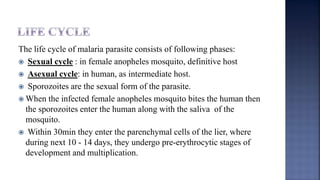This document provides an overview of malaria, including its definition, causative organisms, life cycle, signs and symptoms, risk factors, complications, diagnosis, and treatment. Malaria is caused by protozoan parasites of the genus Plasmodium and transmitted via mosquito bites. It presents with fever, chills, and flu-like symptoms. Risk factors include living in endemic areas and pregnancy. Complications can include severe anemia, renal failure, liver dysfunction, and death if falciparum malaria is not treated. Diagnosis involves examining blood smears under a microscope. Treatment depends on the parasitic species but generally involves antimalarial medications like chloroquine or artemesinin combination therapies.



















































